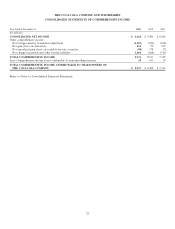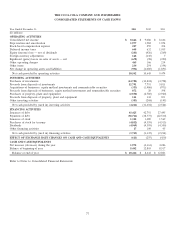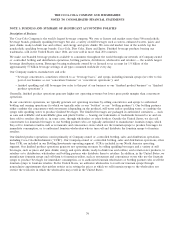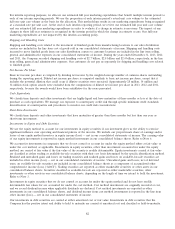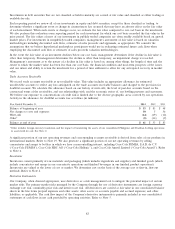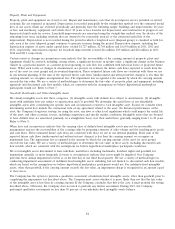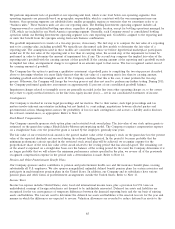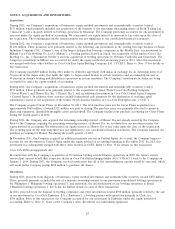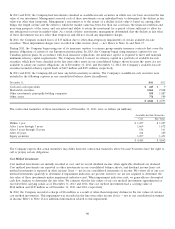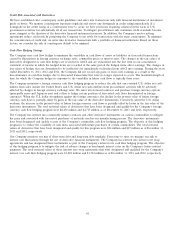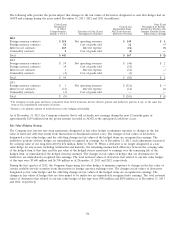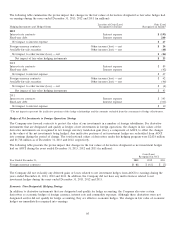Coca Cola 2013 Annual Report Download - page 87
Download and view the complete annual report
Please find page 87 of the 2013 Coca Cola annual report below. You can navigate through the pages in the report by either clicking on the pages listed below, or by using the keyword search tool below to find specific information within the annual report.We perform impairment tests of goodwill at our reporting unit level, which is one level below our operating segments. Our
operating segments are primarily based on geographic responsibility, which is consistent with the way management runs our
business. Our operating segments are subdivided into smaller geographic regions or territories that we sometimes refer to as
‘‘business units.’’ These business units are also our reporting units. The Bottling Investments operating segment includes all
Company-owned or consolidated bottling operations, regardless of geographic location, except for bottling operations managed by
CCR, which are included in our North America operating segment. Generally, each Company-owned or consolidated bottling
operation within our Bottling Investments operating segment is its own reporting unit. Goodwill is assigned to the reporting unit
or units that benefit from the synergies arising from each business combination.
The goodwill impairment test consists of a two-step process, if necessary. The first step is to compare the fair value of a reporting
unit to its carrying value, including goodwill. We typically use discounted cash flow models to determine the fair value of a
reporting unit. The assumptions used in these models are consistent with those we believe hypothetical marketplace participants
would use. If the fair value of the reporting unit is less than its carrying value, the second step of the impairment test must be
performed in order to determine the amount of impairment loss, if any. The second step compares the implied fair value of the
reporting unit’s goodwill with the carrying amount of that goodwill. If the carrying amount of the reporting unit’s goodwill exceeds
its implied fair value, an impairment charge is recognized in an amount equal to that excess. The loss recognized cannot exceed
the carrying amount of goodwill.
The Company has the option to perform a qualitative assessment of goodwill prior to completing the two-step process described
above to determine whether it is more likely than not that the fair value of a reporting unit is less than its carrying amount,
including goodwill and other intangible assets. If the Company concludes that this is the case, it must perform the two-step
process. Otherwise, the Company will forego the two-step process and does not need to perform any further testing. During 2013,
the Company performed qualitative assessments on approximately 11 percent of our consolidated goodwill balance.
Impairment charges related to intangible assets are generally recorded in the line item other operating charges or, to the extent
they relate to equity method investees, in the line item equity income (loss) — net in our consolidated statements of income.
Contingencies
Our Company is involved in various legal proceedings and tax matters. Due to their nature, such legal proceedings and tax
matters involve inherent uncertainties including, but not limited to, court rulings, negotiations between affected parties and
governmental actions. Management assesses the probability of loss for such contingencies and accrues a liability and/or discloses
the relevant circumstances, as appropriate. Refer to Note 11.
Stock-Based Compensation
Our Company currently sponsors stock option plans and restricted stock award plans. The fair value of our stock option grants is
estimated on the grant date using a Black-Scholes-Merton option-pricing model. The Company recognizes compensation expense
on a straight-line basis over the period the grant is earned by the employee, generally four years.
The fair value of our restricted stock awards is the quoted market value of the Company’s stock on the grant date less the present
value of the expected dividends not received during the relevant holding period. In the period it becomes probable that the
minimum performance criteria specified in the restricted stock award plan will be achieved, we recognize expense for the
proportionate share of the total fair value of the award related to the vesting period that has already lapsed. The remaining cost
of the award is expensed on a straight-line basis over the balance of the vesting period. In the event the Company determines it is
no longer probable that we will achieve the minimum performance criteria specified in the plan, we reverse all of the previously
recognized compensation expense in the period such a determination is made. Refer to Note 12.
Pension and Other Postretirement Benefit Plans
Our Company sponsors and/or contributes to pension and postretirement health care and life insurance benefit plans covering
substantially all U.S. employees. We also sponsor nonqualified, unfunded defined benefit pension plans for certain associates and
participate in multi-employer pension plans in the United States. In addition, our Company and its subsidiaries have various
pension plans and other forms of postretirement arrangements outside the United States. Refer to Note 13.
Income Taxes
Income tax expense includes United States, state, local and international income taxes, plus a provision for U.S. taxes on
undistributed earnings of foreign subsidiaries not deemed to be indefinitely reinvested. Deferred tax assets and liabilities are
recognized for the tax consequences of temporary differences between the financial reporting basis and the tax basis of existing
assets and liabilities. The tax rate used to determine the deferred tax assets and liabilities is the enacted tax rate for the year and
manner in which the differences are expected to reverse. Valuation allowances are recorded to reduce deferred tax assets to the
85


